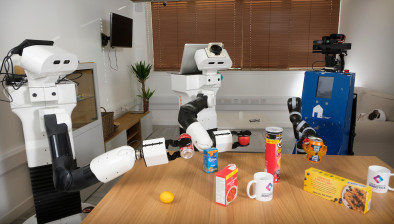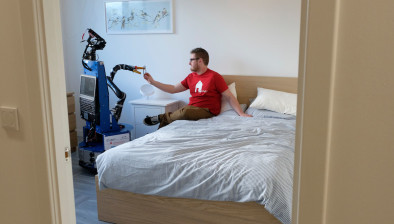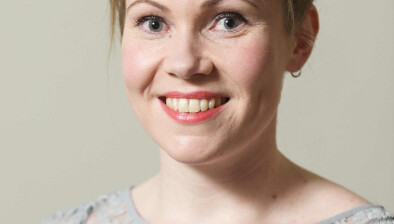Robotics and care event demonstrates world-first for assisted living technology users
A collaborative robotics and social care event has brought together innovators and end-users in a week-long burst of creativity around assistive technology, supported by the world’s first example of an open assisted living laboratory.
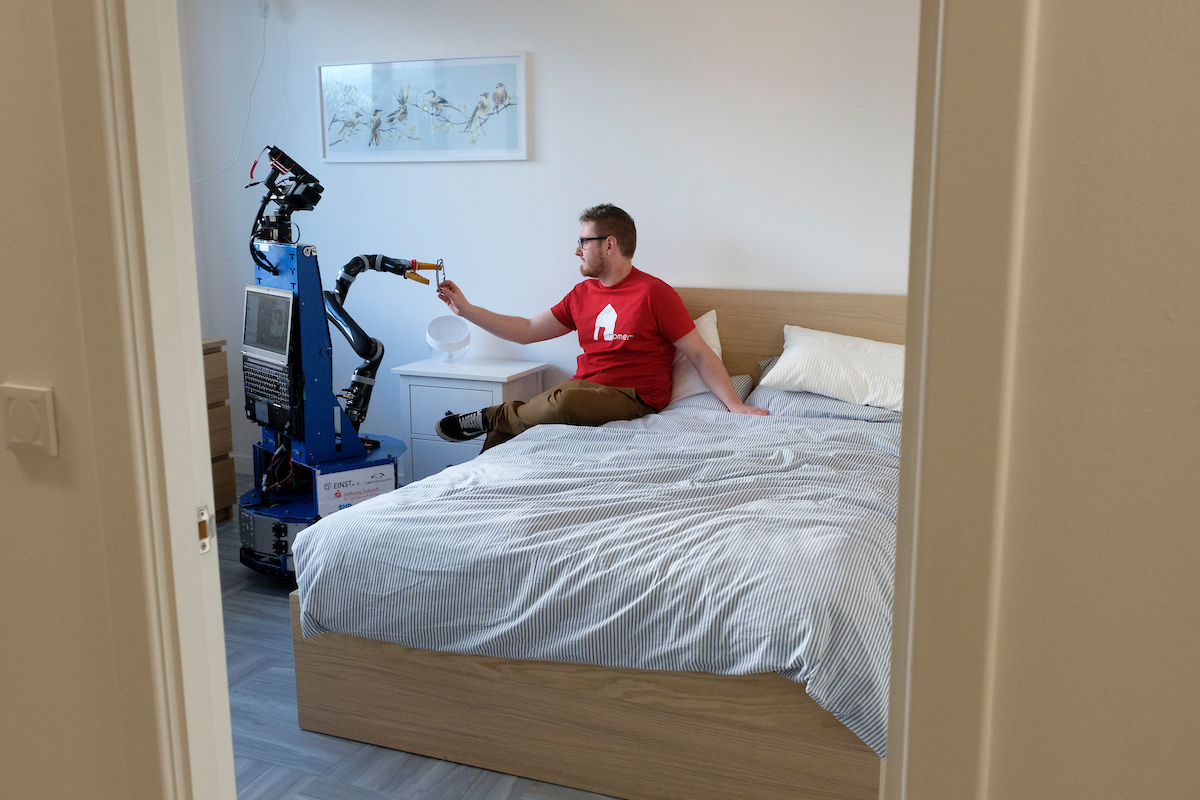
Highlights included connecting multiple home appliances with a single in-ear switch, and new concepts for using technology to help support social isolation and existing care packages.
The event was organised by The National Robotarium, based at Heriot-Watt University, in partnership with Product Forge, the Usher Institute and Design Informatics at the University of Edinburgh and Scottish Health Innovations Ltd (SHIL).
Attended by health and care professionals, academics and assistive technology providers, it aimed to prototype new solutions and accelerate technical designs to tackle multiple care and assisted living challenges.
Dr Mauro Dragone, an assistant professor and director of the Robotic Assisted Living Testbed (RALT) at the National Robotarium, based at Heriot-Watt University, co-organised the event.
He explained: “The National Robotarium’s mission is to translate cutting-edge research into technologies to create disruptive innovation in an expanding global market, delivering sustainable economic benefit to Edinburgh, the UK and beyond.
“Our Robotics and Care Mashup exemplifies the concept of a user-centred living lab, integrating concurrent research and innovation processes within a public-private-people partnership. We involved a range of stakeholders in the event to define research priorities and questions for health and social care technology and to accelerate innovation in the sector.
“Our assisted living lab is set up to operate like a real flat with a kitchen, living room, bathroom and bedroom. Throughout the home, we have connected sensors, domestic robots and other assisted living technology to help care practitioners, designers and end users to test the usefulness of assisted living technologies. Through our Open Ambient Assisted Living (OpenAAL) project, we have recently equipped our laboratory to offer real-time interaction with its sensing, automation and robotic equipment, over the internet.
“This provides a platform that researchers, technology and industry users can use to co-create technology, where time and distance is no longer a barrier – any time, any place access. The aim is to catalyze and support collaborations to more quickly develop innovative concepts of assistive living technology to be considered for mass-market roll-out and rapid uptake.”
A line-up of fourteen international speakers inspired participants throughout the week with talks providing multiple perspectives on key aspects for assistive technology, from social science and cybersecurity to IoT and ethics for healthcare and social robotics.
Participants were also mentored by representatives from the Discovery Stage sponsor Scottish Health Innovations Ltd (SHIL), and the Scottish Social Service Council (SSSC), Scotland’s Innovation Centre for sensing, imaging and Internet of Things (IoT) technologies (CENSIS), the Institute of Design Informatics at University of Edinburgh, and the Digital Health & Care Innovation Centre.
Successes from the week’s event included demonstrating how the ‘Earswitch’ can be used to operate multiple devices using an ear muscle alone. This could significantly improve the independence of thousands of individuals with a range of assisted living needs.
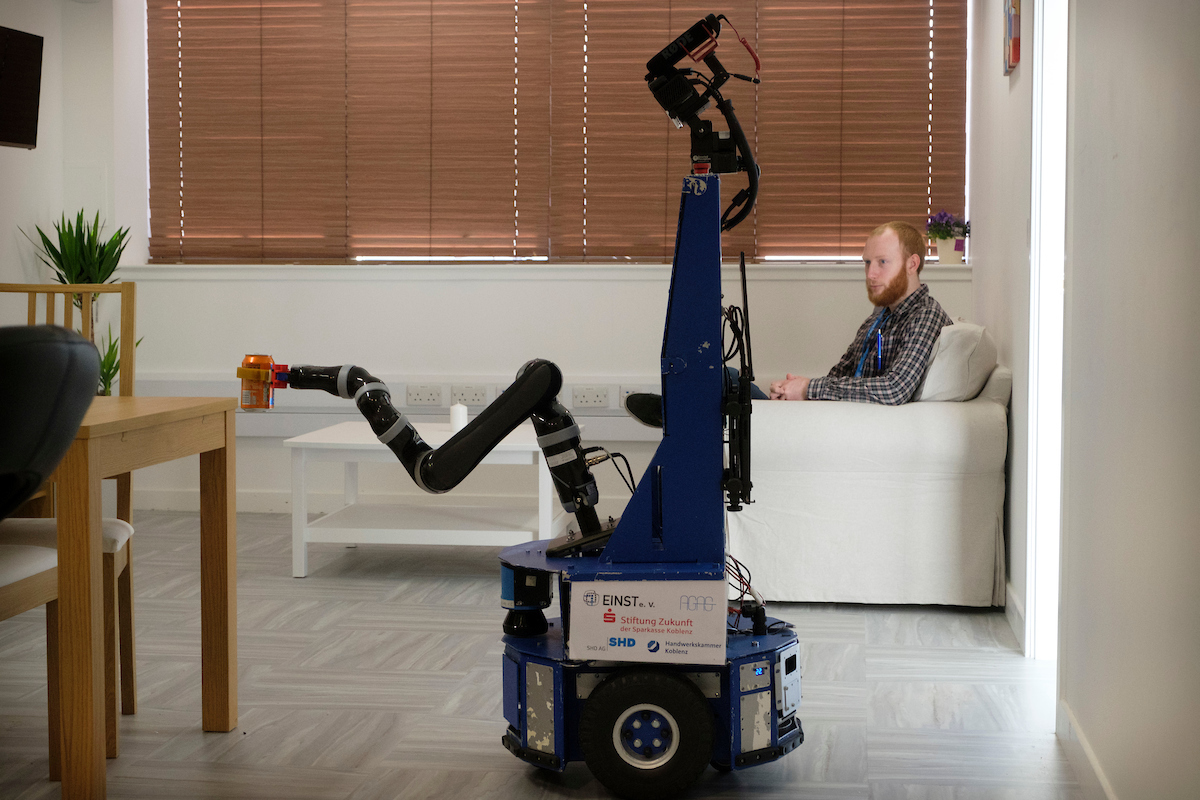
The ‘Earswitch’ was created by primary care practitioner, Dr Nick Gompertz, from Somerset and is supported by funding from NIHR. Dr Gompertz previously proved voluntary movements of the eardrum could be filmed and then used to trigger a virtual keyboard for MND and complex stroke sufferers.
Explaining his involvement in the event, Dr Gompertz, inventor of the Earswitch, said: “The Mashup has helped to accelerate and widen the applications of the Earswitch prototype. During the event, we’ve used the Earswitch to control disability software which then can connect to devices throughout the National Robotarium’s assisted living lab and beyond. This allows a user to control multiple appliances in a home setting with their ear muscle alone.
“Everyone with assisted living needs faces a unique set of challenges so they can end up with multiple devices to support their needs. The updated Earswitch prototype can now control a single access point from which to surf the internet, control wheelchairs, operate home appliances and even play computer games.”
Team Communicare, led by Dr Mel McKendrick, assistant professor, School of Social Science, Psychology, at Heriot-Watt University, was declared the event’s winner with their concept for technology-aided social cognition and human interaction.
Dr McKendrick said: “Social isolation is associated with poor mental health and is a significant concern in an older population, whether in their own homes, residential homes or hospitals. It is also applicable to single parent families, individuals with mental health challenges, offenders, homeless people and linguistically and culturally diverse individuals including migrants and refugees. However, recipients of existing befriending services report varying experiences with challenges in the relationship between befriender and befriending recipients in social perception. This may impact on the success of the befriending.”
The runners-up, team Curi-O, led by Rakin Sarder, MSc student in Human-Robot Interaction at Heriot-Watt University, proposed a post-discharge robotic nursing service model for patients who are recovering in their homes after their treatment.
Mr Sarder said: “Many medical treatments require patients to follow specific recovery guidelines following their discharge. Studies have shown that this recovery process can be a challenging phase for patients, especially if they have physical or cognitive impairments. Solutions such as in-home nursing are expensive.
“Curi-O service could be used by healthcare professionals as a telehealth, telemedicine, telemonitoring and teletherapy medium, enabling them to perform routine check-ups and generally provide social, cognitive, and physical assistance through a social telepresence robot when needed.”
Discovery Stage sponsor Scottish Health Innovations Ltd (SHIL) worked with health and care professionals, technologists and designers over the five-day hackathon to support emerging ideas.
Graham Watson, executive chairman of SHIL, commented: “Now more than ever, innovation that accelerates improvements in patient care is a vital focus. Scotland and the rest of the UK has an incredible wealth of expertise and these ground-breaking events provide an opportunity to foster collaboration across the healthcare innovation ecosystem and solve real problems in the care sector. We look forward to driving forward more exciting innovations with the teams involved.”
The Earswitch team also worked with Nick Laing from smart home company, Function Control to operate real home functions including lighting, heating and motorised blinds during the live event, and with assistive tech companies Smartbox and GetTecla. As well as controlling simple switching commands, the team now intends to combine biometric data from the Earswitch with smart home monitoring data to build a picture of a person’s overall health, daily routines and activities in the home.





